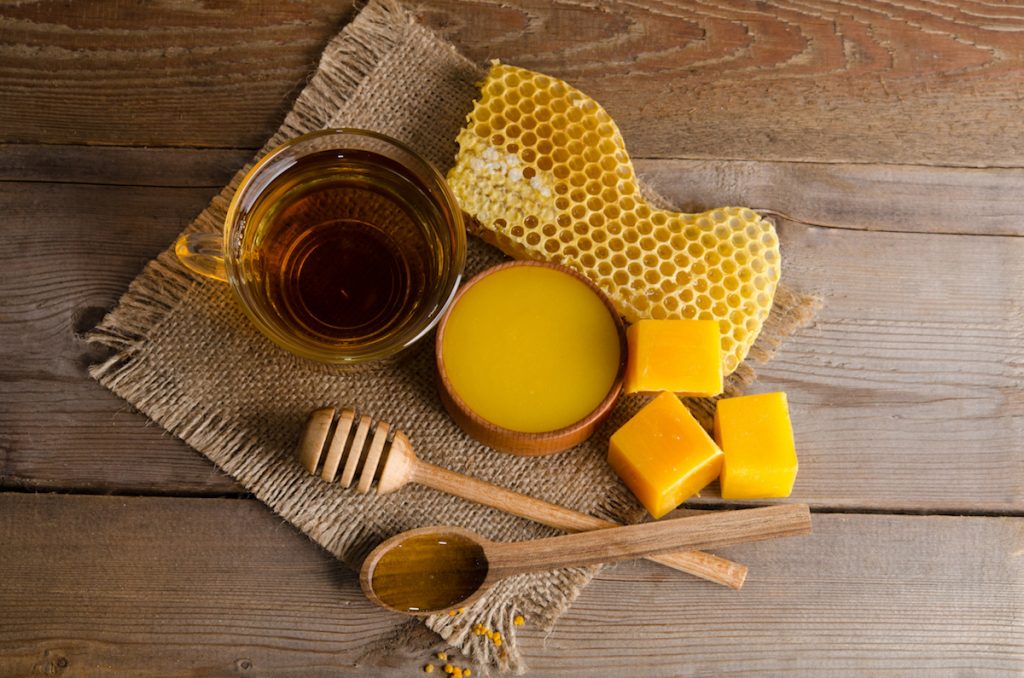What is Beeswax?

Did you know that everything that a honey bee makes is useful in some way? Of course, we are all familiar with the benefits and uses of honey. But, honeybees don’t stop there! They make a few other vital resources that can be used by humans: bee pollen, royal jelly and beeswax. Beeswax may not get as much attention as honey, but it plays a significant role in the success of the colony.
If you haven’t guessed by now, honeybees live a very orderly existence. They each have their jobs within the colony, including nurses, foragers, cleaners and even the queen herself. So, it makes sense that their homes are just as planned out and functional as the bees themselves. Their hives are made up of tiny, hexagon-shaped cells that are perfectly designed to provide the maximum amount of storage space using the least amount of beeswax.
In this post, we’re going to learn about beeswax: what it is, how it’s made and how we can use it in our homes, skincare products and for our health.
What is Beeswax?
Beeswax is the building block of the hive. Honeybees from the genus Apis produce it to build the hexagon-shaped honeycomb where bees live, work, raise their young and store their food supplies. In its natural form, beeswax is actually white or translucent. It becomes the light golden color we associate with beeswax when stained by pollen or propolis. Beeswax is made up of about 300 different compounds. Its composition can vary slightly depending on where the honeybees live.
Worker bees are responsible for producing beeswax. They have special glands on the underside of their abdomens that secrete the wax in thin sheets called scales. Let’s follow one of the worker bees through the process of producing beeswax!
How Do Bees Make Beeswax?
The first step begins with a worker bee leaving the hive to forage for pollen and nectar. These bees pass on nectar and honey to other bees who will consume it and turn it into wax. Honeybees need vast amounts of nectar to produce wax. In fact, a bee will eat six to eight pounds of honey to make just one pound of beeswax!
Once the sugar has been converted into wax, the bees will begin to secrete it through their special glands. The wax starts out as small flakes but is shaped and molded by the other bees in a fascinating way. The bees will form a chain and pass the secreted wax down the line. Each bee will take their turn chewing the wax to make it soft and pliable.
Once the wax reaches the ideal condition, the bees can begin to construct the hexagon-shaped honeycombs. The combs are then filled with honey and capped off with more wax to prevent moisture loss.
How Do We Get Beeswax?
Most beekeepers get their beeswax from the wax caps that cover each honey cell. Using a hot knife, a beekeeper will remove the caps, collect them and then melt them to separate the wax from any residual honey. Since the wax is lighter than the honey, it will rise to the top. The beekeeper will remove the top layer of wax and allow it to cool and become a solid mass of beeswax.
The Benefits of Beeswax
Like everything that bees make, beeswax has certain properties that make it very useful around the house. And, because it is a natural substance, many people choose home, beauty and wellness products that contain beeswax over those filled with unknown and potentially harmful chemicals. Beeswax is loved by people all around the world because of its nourishing and healing properties.
Beeswax is beneficial because it:
- Seals in moisture so it is a fantastic remedy for dry skin
- Contains antioxidants that produce shiny, glowy skin
- Acts as a sealant to protect skin from harmful environmental toxins
- Protects skin while still allowing it to breathe
- Is anti-inflammatory so it can help heal cuts and bruises
- Contains vitamin A which promotes cell regeneration
12 Ways You Can Use Beeswax Around the House
The benefits of beeswax make it a common ingredient in many natural household products. And it just smells good! There is so much that we can do with beeswax. Here are just some of our favorite ways to use it:
- Lotion bars
- Lip balm
- Body balm
- Beeswax candles
- Soaps
- Salve for cracked hands and feet
- Reusable food wraps
- Greasing squeaky drawers or doors
- Polishing dull furniture
- Natural healing for cuts and burns
- Waxed thread for sewing
- Acne or eczema treatment
Are you convinced of the amazing nature of beeswax? There is so much more we could share about beeswax, but we hope that this brief overview gives you a little more knowledge about the fascinating lives of honeybees.
